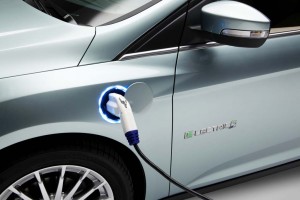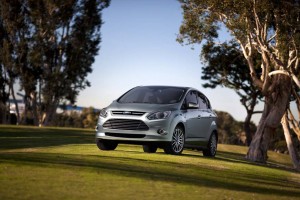With gas nudging $4 a gallon — and some pundits predicting it will nip the $5 mark by summer — it’s not a bad time to be adding some new high-mileage models to your fleet. Actually, most manufacturers are doing that these days, but Ford wants to go a step further, not only promising a big jump in mileage for its entire line-up but declaring that it now sells “America’s most fuel-efficient five-passenger car.”
According to the official EPA endorsement, that title goes to the new Ford Focus Electric, the battery-powered version of the maker’s latest-generation compact 5-seater. The government rates the Focus Electric at 105 MPGe – or miles per gallon-equivalent – in the combined City/Highway column, or a full six ahead of the Nissan Leaf.
The pure battery-electric vehicle is one of five “BEVs” and plug-in hybrids the maker is planning to bring to market. It follows the limited-edition launch of a battery-electric Transit Connect van and will be followed by plug-in hybrid versions of the Focus and the new Ford C-Max microvan, both of those to be labeled “Energi,” a term Ford apparently is reserving for plug-ins. The Detroit maker has yet to identify what the fifth battery car will be.
Ford has been struggling to position itself as a fuel economy leader with offerings like the outgoing Escape Hybrid SUV and the Fusion Hybrid sedan. The latter model will be replaced with an all-new version that Ford expects to deliver about 47 mpg – no “e” there – when it reaches market later this year. That would be at several miles a gallon ahead of the comparably sized Toyota Camry Hybrid, though still a bit back of the Japanese maker’s dedicated Prius hatchback.
As for the Escape, Ford is dropping the hybrid version when the 2013 remake hits market but will shift to a version of its well-regarded EcoBoost driveline which should yield similar mileage but improved towing and performance.
Ford is counting on the various new EcoBoost models to give it a more cost-effective alternative to battery power, using the technology even in some of its biggest products, such as the F-Series pickup.
“Ford is giving customers the power of choice for leading fuel economy regardless of what type vehicle or powertrain technology they choose,” Focus chief engineer Eric Kuehn proclaimed during a preview of the new battery car.
In the case of the Focus Electric, fuel efficiency comes at a stiff price, the new model going for $39,200 – plus $795 shipping. That’s nearly $2,000 less than the Chevrolet Volt plug-in – though it doesn’t get you the back-up gas motor to keep going when the battery runs down.
Meanwhile, Nissan’s Leaf comes in at a more modest $35,200, while the Mitsubsihi i is going off for at $29,125 – plus shipping for both.
The EPA-approved label will suggest that the Focus Electric gets the equivalent of 110 MPGe in the City, 99 on the Highway cycle, and can go 76 miles under average driving conditions between charges. That’s three miles longer than the Nissan Leaf – though range can vary widely depending on road conditions and driving style.
Nonetheless, the so-called “Munroney sticker” buyers will see will suggest the Ford Electric should save $9,700 on fuel costs over a five-year ownership cycle. And that figure could rise significantly as gas prices go up.
At a session to preview the new Focus Electric, Ford’s retiring global product development chief, Derrick Kuzak, gave a hint of the maker’s longer-term fuel economy plans. He suggested the maker wants to boost the mileage of its typical vehicle by at least 20% between now and 2020.
Technologies like the battery drivelines in the Focus Electric and C-Max Energi, as well as the various EcoBoost offerings will help.
But Ford also is putting a premium on weight reduction, said Raj Nair, who will replace Kuzak this spring. Confirming a report first published by TheDetroitBureau.com a year ago, he said the goal is to shave about 700 pounds of mass off new products, going forward.
Mass, as engineers frequently note, is the enemy of efficiency, and each 100 pounds can yield mileage savings of as much as a mile a gallon. The added benefit is improved vehicle dynamics – though, as with adding battery power, reducing weight can be costly as a maker like Ford adopts new materials such as aluminum and even carbon fiber. That material has, until now, been limited to exotic and luxury vehicles but many manufacturers expect it to migrate into the mainstream going forward.
Ford Boasts About Mileage
Here’s a pretty good boast: Ford says its new Focus Electric is now “officially America’s most fuel-efficient five-passenger car.”
That means the electric car is now certified at 110 miles per gallon equivalent (MPGe) in city driving and 99 MPGe on the highway. Combined, the rating is 105 MPGe, which is 6 more than Nissan’s all-electric Leaf. MPGe is that weird government rating system that assumes since it took burning of natural gas, coal or oil to create the electricity that powers plug-in vehicles, it should be counted in its fuel economy total.
While Ford was at it, it found other ways to take some shots at the Leaf as well. Focus Electric has more passenger room and a faster charging system, for instance, the Blue Oval says.
“Ford is giving customers the power of choice for leading fuel economy regardless of what type of vehicle or powertrain technology they choose,” said Eric Kuehn, chief nameplate engineer, Focus Electric.
The EPA-approved Focus Electric label also certifies that the car has a range of 76 miles on a single charge, compared with the 73-mile range of the Leaf. The Focus Electric can be driven up to 100 miles on a single charge depending on driving habits. The average driver drives 29 miles a day, according to the Bureau of Transportation Statistics website.
The approved label also will say customers could save $9,700 in fuel costs over the course of five years compared with the average new vehicle. Comparative savings could go even higher if the current trend of rising gas prices continues. In California alone, the cost for a gallon of gas rose 20 cents in a seven-day period that ended last week.
But saving that money won’t come cheap: Ford has priced the Focus Electric at $39,200, plus $795 shipping. For about the same price a buyer could get a Chevrolet Volt plug-in rated for 36 miles on electric, but with a gas engine that kicks in for unlimited range. And among all-electrics, the Nissan Leaf that Ford takes shots at is cheaper at $35,200, as is the Mitsubishi i that starts at $29,125.
Production of the Focus EV is being ramped up slowly at Ford’s Wayne, Mich., plant and dealers in the two launch markets — California and New York-New Jersey — have begun taking orders. Ford says it plans to offer the car in 19 U.S. markets by the end of this year.
The Focus Electric is one of several plug-ins Ford plans to offer. The Transit Connect Electric (built with a partner) is on sale now and coming are a plug-in hybrid version of the redesigned 2013 Fusion and a plug-in hybrid C-Max micro-van.
Ford Mileage Hike
Ford will increase the fuel economy of its U.S. vehicles at least 20% by 2020 — a goal aided by the launch of a Focus rated at 105 miles per gallon, the company’s top vehicle-development executives said Friday in Dearborn.
Overall, Ford will use new technologies, lightweight materials and various levels of electrification, said two Ford executives, Derrick Kuzak, the company’s retiring global product development boss, and his successor, Raj Nair.
Ford is entering the second phase of its long-term program to reduce oil consumption and build more electric and alternative-fuel vehicles, Kuzak said.
“This is a 30-year story,” said Kuzak, adding that every vehicle that Ford introduces should be a leader in fuel economy.
This year’s fuel improvements will come from auto-stop, which shuts off the 2013 Fusion’s engine at stoplights, new hybrid and battery-powered vehicles, and wider use of turbocharging and direct fuel injection, which uses gas more efficiently. And there’s more:
Ford also plans to reduce the weight of every new vehicle by up to 700 pounds, depending on the model. The upcoming Transit commercial van will shave more than 300 pounds from the E-series van it replaces, for example, Nair said.
Ford expects gasoline and hybrid versions of the new Fusion that debuts this fall to be very competitive with cars including the Chevrolet Malibu Eco, Hyundai Sonata, Nissan Altima and Toyota Camry.
Economic growth in developing nations around the world will increase fuel demand — and oil prices — for at least the next 10 years, Ford economist Ellen Hughes-Cromwick said.



Paul,
I *think* the Focus will come as an EV only, and the C-Max will be offered as a hybrid, and the C-Max Energi will be the PHI offering. I believe the Fusion will follow this same protocol, with a hybrid and a PHI “Energi” version.
Yes, Lincoln, I believe you ARE correct that there will not be a plug-in Focus, nor — for now, anyway — a full battery-electric C-Max.
Paul A. Eisenstein
Publisher, TheDetroitBureau.com
PHI = PIH sorry about that